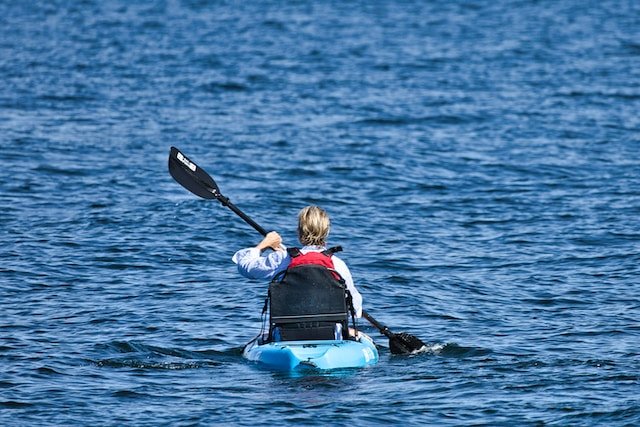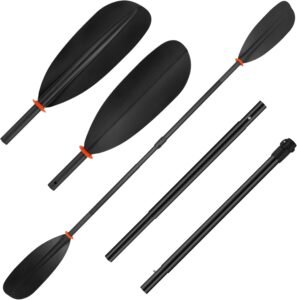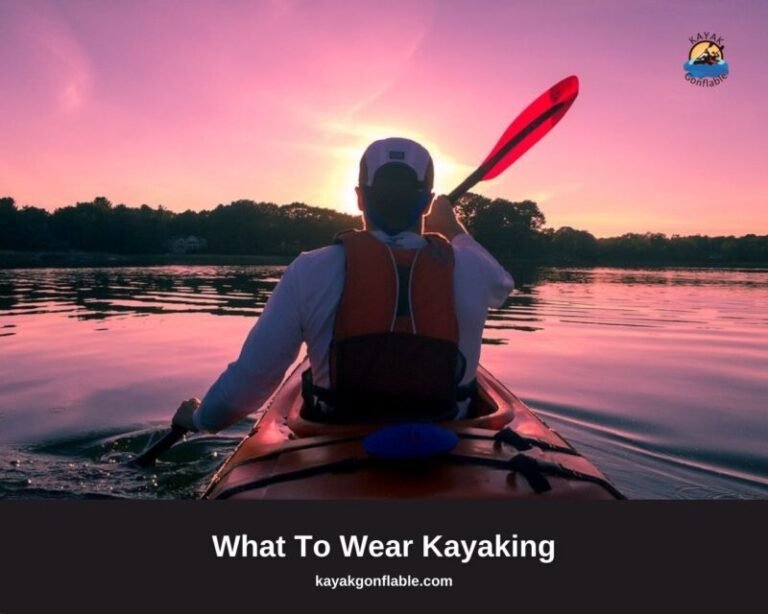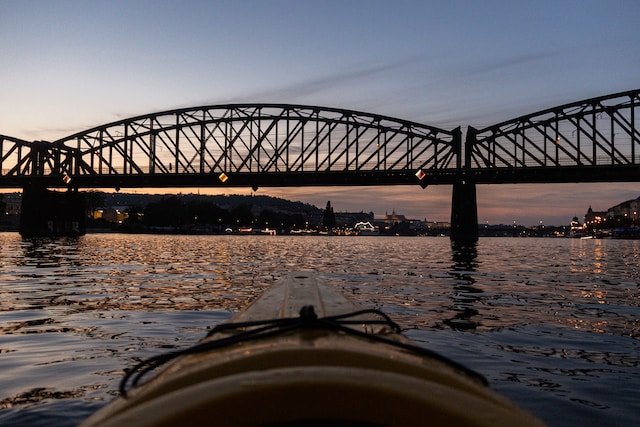How To Kayak: A Detailed Beginner’s Guide

Kayaking is a famous paddle sport whose popularity grows every day. The sport is an excellent way to work out while having fun or even seeking exhilaration and the thrill of danger.
Kayaking accommodates paddlers of all ages and fitness levels. Naturally, as the sport becomes more widely known, more and more people find themselves drawn to its charms and start to wonder what exactly kayaking entails and whether they can partake in it.
The beginning of a thing is very crucial, and as such, this article provides beginners with the knowledge they need to make their kayaking adventure fun. Read on and have fun!
What is kayaking?
Kayaking is a water sport in which the player sits in a small watercraft known as a kayak and uses a double-bladed paddle to move through the water. It is believed that kayaking originated in the Arctic region, where it was used by the Inuit people for transportation and hunting.
Today, kayaking is enjoyed by people of all ages and abilities all over the world. It is a great way to enjoy the outdoors, get some exercise, and even learn some new skills.
Kayaking is considered both a recreational and competitive activity, and there are many different types of kayaks available to suit different styles of paddling.
Kayaks are designed for both solo and tandem paddling and can be used in a variety of settings, including rivers, lakes, and the ocean. Kayaks can be used for touring, whitewater kayaking, fishing, and even camping.
Benefits of Kayaking
If you are not yet sold that kayaking is for you and you’re reading this out of curiosity or for someone, knowing some of the benefits of this great sport might go a long way in changing your mind and making you realize that kayaking is in fact for everyone. The benefits of kayaking are given below.
- Kayaking is a low-impact activity that is easy on the joints.
- It is a great way to get some exercise without feeling like you are working out.
- Kayaking can be a great way to relax and de-stress.
- Kayaking is an excellent way to connect with nature.
- It can be a great way to bond with friends or family.
- Kayaking is a great way to get some fresh air and vitamin D.
- It is a great way to improve your balance and coordination.
What You’ll Need To Start Kayaking
Now that you have an idea of what kayaking entails and know the benefits of this paddle sport, let’s look at the equipment you’ll need to start kayaking.
Since you are just developing an interest in the sport or just starting to act on your interest, renting or borrowing the equipment you’ll need is a wise course of action.
The reason is that it allows you to test all the available kayaking equipment so you can make the best choice when purchasing your own, or in the worst-case scenario, you don’t lose much should you decide to forsake kayaking in the near future.
The equipment needed to start your kayaking adventure is given below.

A kayak
Naturally, you can’t kayak without a kayak, so it should come as no surprise that it is the first and perhaps most important piece of equipment you should procure. Kayaks are small watercraft that are paddled with double-bladed paddles.
Several types of kayaks exist, such as recreational kayaks, sea kayaks, touring kayaks, fishing kayaks, whitewater kayaks, and inflatable kayaks, but as a beginner, you are advised to go for a recreational kayak.
The kayak you pick ultimately depends on the conditions you intend to kayak in. Kayaks can be solo (for a single paddler) or tandem (designed for two paddlers).
Kayaks are broadly divided into two categories based on their cockpit style. They are sit-in kayaks and sit-on-top kayaks.
Sit-in Kayaks
Sit-in kayaks are a popular kayak type among paddlers and are great for both beginners and experienced kayakers. These kayaks are so named because of their closed cockpit design.
This implies that they have a well-defined sitting area and that the paddler can sit comfortably while paddling his vessel.
Pros
The pros of sit-in kayaks include:
- The closed cockpit design provides better protection from the elements, making these kayaks ideal for any environment, particularly when the weather is cold and you are avoiding the water.
- When well paired with a spray skirt, a sit-in kayak can keep water out of the vessel even in the event of capsizing, so it is great for those who want as little contact as possible with the water.
- Sit-in kayaks offer a more comfortable experience, as you don’t have to constantly adjust your position to stay balanced.
- They are more stable and maneuverable than sit-on-top kayaks.
- They have more storage space than their sit-on-top counterparts.
Cons
Some cons of sit-in kayaks include:
- Sit-in kayaks are typically more expensive than their sit-on-top counterparts.
- Their closed cockpit design makes them more difficult to get in and out of, especially if you are not used to them.
- The restriction of the closed cockpit can become uncomfortable if you are paddling for long periods of time.
- It is generally more difficult to get back into sit-in kayaks should you tip over.
Sit-on-top Kayaks
As opposed to the previous kayak type, these kayaks have an open cockpit design. Sit-on-top kayaks are a type of kayak designed for the paddler to sit on top of, rather than inside.
They are popular for many different types of kayaking, including recreation, fishing, and surfing. Sit-on-top kayaks are easy to get in and out of and offer a great deal of freedom and flexibility for the paddler.
Pros
Some advantages of sit-on-top kayaks are given below.
- They are easy to get in and out of due to their open cockpit design.
- Sit-on-top kayaks are cheaper than their sit-in counterparts.
- They are ideal for hot weather as you are not enclosed in a cockpit.
- Sit-on-top kayaks are self-bailing as they possess scupper holes that help drain any water that enters the kayak, thus preventing swamping. Those holes also come in handy when locking the kayak.
- They are easier to reboard should the vessel tip over.
Cons
Some cons of sit-on-top kayaks are given below.
- Their open cockpit design exposes the paddler to the wrath of the elements, making them unideal for cold weather conditions.
- They are less stable than their sit-in counterparts, particularly in windy or rough water conditions.
- Sit-on-top kayaks are more difficult to maneuver, especially in tight corners.
- Their higher center of gravity makes them less efficient to paddle than their sit-in counterparts.

A Paddle
Of course, once you have an appropriate kayak, you will need a paddle. Using a paddle suited to your height, kayak width, and paddling style can make a world of difference in your kayaking experience, so be sure to choose the right one.
Consider the materials the paddle is made from, the shape of the blade, the brand, and any other information of note when choosing your paddle. You will find a paddling size guide very helpful at this stage.

Life Jacket
A life jacket is an essential piece of equipment for anyone starting out in kayaking. It is a personal flotation device that helps to keep the wearer afloat in the water and can be invaluable in a kayaking emergency.
Wearing a life jacket while kayaking can help to prevent drownings and other serious injuries. Life jackets can also help protect you from the elements. It is thus crucial you choose a good life jacket that will fit you properly and be comfortable to wear.
Also, make sure your life jacket is appropriate for the water conditions you will be kayaking in, and learn how to use it properly.
Kayaking Gear and Clothing
While the kayak, paddle, and life jacket are the most important pieces of equipment a kayaker needs for a safe trip, they are not the only equipment at your disposal.
If you want an enjoyable and comfortable adventure, you will have to wear appropriate clothing and get at least some of the gear below.
- Spray skirt: To help keep water out of your kayak cockpit and keep yourself dry.
- Bilge pump: To get rid of any water that may enter your kayak.
- Snacks: To provide energy as paddling is serious work. Bringing a more elaborate lunch and taking a break is also essential if you plan on paddling for long hours.
- Drinking water: To keep yourself hydrated on the water.
- Sun protection: This implies the use of sunscreen, sunglasses, lip balm, shades, and any other means you can use to protect yourself from the sun’s ultraviolet rays.
- Dry bags: To help keep whatever you don’t want wet dry.
- Kayak lights: For kayaking at night or in conditions with low visibility.
- Watch: To help time yourself and plan your trip.
- Whistle: To call for aid in the event of an emergency. Having a flare at hand could also be handy for similar reasons.
For clothing, you are advised to wear things that will dry easily, especially when kayaking in cold weather. This means no material made of cotton or other slowly-drying material should be in your kayak clothing arsenal.
Your clothing is also weather-dependent. In summer or hot weather, you can make do with light clothing, but when kayaking in cold weather, you want to make sure your clothing retains warmth.
You can ask your kayaking instructor more about appropriate clothing for each weather or water condition.
How To Start Kayaking
Once you’ve either borrowed, rented, or purchased all you need to kayak, I advise getting a kayaking instructor.
While it is true that you can learn the sport online or on your own, having an experienced kayaker around to give you some pointers will save you a lot of trouble and make your learning process easier.
If you prefer doing things in a group, you can join a local kayaking club and take part in their exercises.
Start simple. Practice getting in and out of your kayak with your instructor. He or she will give you pointers to make the task easier, call you out on any mistakes you make, and inform you of common beginner mistakes you should avoid.
Your starting point could be in a quite large swimming pool or any body of flat water around you.
Next, you should work on safely getting your kayak into and out of the water. While this may seem unimportant, its value should not be underestimated.
If you want your kayak to stand the test of time, you must handle it with care, and part of that care is properly setting your kayak in the water. Launching the kayak should also be practiced, and even how to bring your paddling session to an end should be discussed.
Your instructor should also enlighten you on the transportation, maintenance, and storage of kayaks. Knowing the dos and don’ts of your watercraft as early as possible will ensure you take better care of it, so take your instructor’s words to heart.
The next milestone should be practicing kayaking strokes. Kayaking strokes are paddling techniques that will help you control your kayak in the water and are indispensable tools if you are to become a kayaking master.
The first of these strokes is the forward stroke, which focuses on the forward momentum and propulsion of the kayak. Some of the others include the reverse stroke and the sweep stroke.
We will speak more about kayaking strokes later in this article. You should, however, keep in mind that, as these strokes are essential to kayaking, they may not be as easy to learn as they sound, so don’t get frustrated if you don’t get it right away.
With a little perseverance and hard work, you should be able to master them in no time.
Once you have mastered the forward stroke, you can have a little semi-supervised paddling session. The aim of this is to determine how much of what you’ve learned has sunk in and how well you can fare on your own.
Remember that kayaking is meant to be fun, so there is no shame in moving at your own pace. These supervised tests with your instructor will also help you build your water legs and develop confidence in yourself.
Continue practicing the kayaking strokes while acquainting yourself with several of the other kayaking techniques out there, like wet exit, rolling your kayak, righting a capsized kayak, portaging your kayak, etc.
The list goes on and is a worthwhile journey for anyone who intends to become an avid kayaker. It won’t be easy, but remember, the journey of a thousand miles begins with a step.
The Basic Kayaking Strokes
Like most sports, kayaking has techniques that, once mastered, make the sport safer and more fun, and chief among them are kayaking strokes. These strokes are paddling techniques to help you control your vessel and without them, you could be in danger.
The four basic kayaking strokes are the forward stroke, the reverse stroke, the sweep stroke, and the draw stroke. They are explained below.
The Forward Stroke
In kayaking, the forward stroke is the most common and basic stroke used to propel the kayak forward in the water.
It is performed by using a double-bladed paddle and is executed by digging one blade of the paddle into the water and then using that same blade to pull the kayak forward.
The other blade of the paddle is then used to provide resistance against the water, acting as a brake of sorts. Put simply, the forward stroke entails paddling on both sides of the kayak to move forward.
You should, however, be sure to keep your strokes even on both sides. The forward stroke is used to move the kayak forward in a straight line and is the building block for more advanced kayaking techniques, so it must be mastered.
The Reverse Stroke
While the forward stroke is the most important of strokes, its opposite, the reverse stroke, is also quite useful. Reverse strokes are an important part of kayaking and are often used to correct course.
They are performed by paddling backward and can be used to stop or slow the kayak. Reverse strokes can also be used to turn the kayak around in tight spaces.
If required, a reverse stroke can also be used to move the kayak backward, a useful skill should you bypass your destination.
The Sweep Stroke
In kayaking, the sweep stroke is used to make turns. It is executed by paddling on one side of the kayak and using the other paddle to sweep the water in a wide arc. The stroke can be used to turn the kayak in either direction.
The sweep stroke is an important part of kayaking and is used frequently when paddling. It is a simple stroke that can be executed quickly and easily.
A sweeping stroke performed on the right side of the kayak will turn the vessel left, while a sweep stroke performed on the left side of the kayak will turn the vessel right.
The Draw Stroke
When paddling a kayak, the draw stroke is used to move the vessel laterally or sideways. It can also be used to turn the kayak in a tight circle.
To execute a draw stroke, reach out with your paddle blade perpendicular to the kayak and pull the blade through the water towards the stern of the kayak. The other arm is used to stabilize the kayak.
The draw stroke can be used on either side of the kayak and is often used in conjunction with other strokes to maneuver the kayak around obstacles in the water, such as rocks or logs.
Safety Tips for Kayakers
Kayaking is a great way to enjoy the outdoors and get some exercise, but it’s important to be safe while you’re doing it. Here are some safety tips for kayakers:
- Always wear a life jacket. It will help keep you afloat should anything dangerous happen on the water.
- Don’t isolate yourself – let someone know where you’re going and when you’ll be back. This will ensure help can come to you even if you are unable to send an emergency alert when things start going south.
- Be aware of the weather conditions – strong winds and waves can make kayaking difficult and dangerous.
- Keep an eye on your surroundings and watch out for obstacles in the water. You want to avoid collisions.
- Never drink and kayak. The effects of alcohol on the water are worse than its effects on land, so drinking before or while kayaking is always a bad idea.
- Follow all local regulations. Rules exist for the safety of all those on the water, so adhering to them is crucial for the safety of lives and property. Obey all local and navigational rules at all times.
- Always check the weather forecast before heading out. That will give you an idea of what to expect on the water.
Advanced Kayaking
As you gain experience in kayaking, you may want to explore more advanced techniques and types of kayaking. Here are some advanced skills to consider:
The Eskimo Roll Technique
The Eskimo roll is an advanced kayaking technique that allows you to recover from a capsized position without exiting the kayak. It’s a valuable skill for advanced paddlers in rough waters. To learn how to do this roll, consider taking lessons from a qualified instructor.
Whitewater Kayaking
Whitewater kayaking is an exhilarating but challenging water sport that involves navigating fast-moving rivers, rapids, and obstacles.
Surf Kayaking
Surf kayaking involves paddling out to sea and riding ocean waves in a kayak. It requires advanced paddle control and wave-reading skills. Ensure to practice in smaller waves before attempting larger swells, and always wear a helmet for safety.
Sea Kayaking
Sea kayaking involves extended journeys on open water, such as coastal or ocean paddling.
Properly Maintaining and Caring For Your Kayak
Proper maintenance and care for your kayak and gear are important to ensure their longevity, safety, and optimal performance. Here is a guide to help you keep your kayaking gear in top shape:
Cleaning and Storing Your Kayak
Removing Saltwater and Debris
After each kayaking trip, rinse your kayak thoroughly with fresh water to remove saltwater and any debris or sand.
Pay special attention to the cockpit, hatch covers, and any exposed metal parts to prevent corrosion. Also, use a soft brush or sponge to gently scrub away any stubborn residue or grime.
Proper Storage
Store your kayak in a cool, and dry area, away from direct sunlight and extreme temperature fluctuations. Ideally, store it indoors or under a kayak cover to protect it from UV rays, which can cause fading and deterioration of the kayak’s materials.
Keep your kayak off the ground using padded kayak stands or racks to prevent warping and damage. Store the kayak upside down or on its side to prevent distortion of the hull shape.
As the paddle sport known as kayaking becomes more popular, it’s no surprise many want to try it out. Kayaking is a great way to exercise and enjoy nature and can be a very rewarding experience if done properly.
As a beginner, you have a long way to go before becoming an experienced kayaker, so to fast-track your journey, you should find an experienced friend or kayaking instructor to put you through.
The first step is to acquire all the necessary gear for a safe and enjoyable trip, then get in your kayak and start paddling under supervision.
Be sure to adhere to instructions and take to corrections. Practice is the next thing on your plate. You should practice all you learn and you will soon be a master.
Remember to obey all kayaking safety rules and adhere to the rules of the water body you are kayaking in. Finally, enjoy yourself and have fun on the water!





